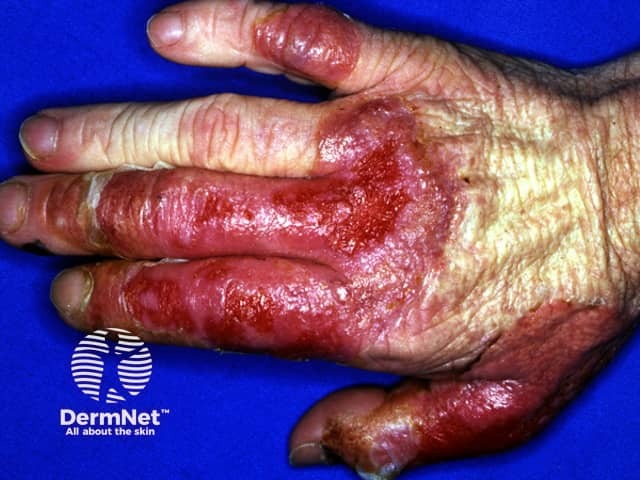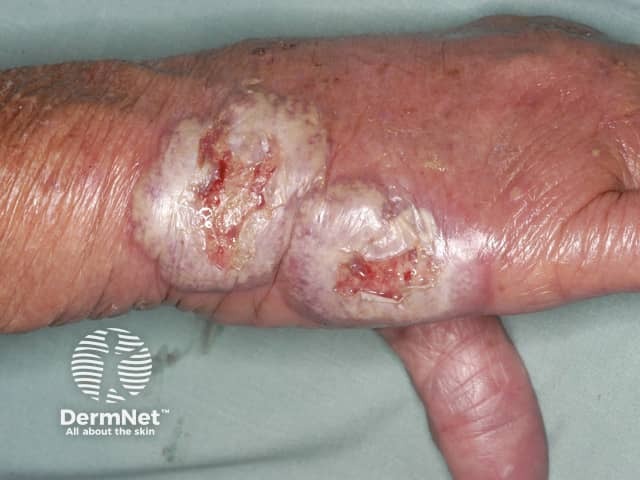Main menu
Common skin conditions

NEWS
Join DermNet PRO
Read more
Quick links
Neutrophilic dermatosis of the hands — extra information
Autoimmune/autoinflammatory Rashes
Neutrophilic dermatosis of the hands
Author: Hon A/Prof Amanda Oakley, Dermatologist, Hamilton, New Zealand, 2012. Updates: September 2015 and May 2023.
Introduction Introduction - neutrophilic dermatoses Causes Diagnosis Outcome Treatment
What is neutrophilic dermatosis of the hands?
Neutrophilic dermatosis of the hands is considered a localised variant of acute febrile neutrophilic dermatosis or Sweet syndrome, in which bluish or grey abscess-like nodules and blisters arise on the hands. They most often occur on the back of the hands, thumb or fingers but sometimes arise on the palmar surface. These nodules may ulcerate.
Neutrophilic dermatosis of the hands was previously known as ‘pustular vasculitis’ of the hands, because inflamed blood vessels are seen on biopsy as well as an infiltration of neutrophil white cells.

Pustular vasculitis

Pustular vasculitis

Pustular vasculitis
What are neutrophilic dermatoses?
Neutrophilic dermatoses are skin conditions characterised by dense infiltration of inflammatory cells (neutrophils) in the affected tissue. They arise in reaction to some underlying systemic illness. A neutrophilic dermatosis may be seen in isolation or more than one type may occur in the same individual.
Neutrophilic dermatoses often arise at the site of injury such as a needle prick, biopsy or insect bite. This reaction to injury is known as Koebner phenomenon or isomorphic response. Pathergy is the production of a papule or pustule at the site of a needle prick.
Neutrophilic dermatoses include:
- Sweet syndrome
- Pyoderma gangrenosum
- Neutrophilic eccrine hidradenitis
- Erythema elevatum diutinum
- Behcet disease
- Bowel bypass syndrome (bowel-associated dermatitis-arthritis syndrome)
What causes neutrophilic dermatosis of the hands?
Neutrophilic dermatosis of the hands develops in reaction to some internal condition. It is mostly seen in elderly patients. It is associated with haematological problems in about half of patients, especially myelodysplasia and leukaemia. Other cases have been reported in association with many other underlying disorders including those listed below.
- Inflammatory bowel disease (e.g. ulcerative colitis or Crohn disease)
- Rheumatoid arthritis
- Influenza vaccination
- Lymphoma, or an internal cancer usually of lung
- Drugs, including granulocyte colony stimulating factor (G-CSF), nonsteroidal anti-inflammatory medications, trimethoprim + sulphamethoxazole and several others
- Neutrophilic dermatosis of the dorsal hands with haematologic malignancy may have a strong association with pulmonary disease
In some people with neutrophilic dermatosis of the hands, no underlying condition is found.
How is the diagnosis made?
Neutrophilic dermatosis of the hands is often diagnosed clinically. A skin biopsy is usually performed to confirm it.
Diagnostic histopathological features of a dense infiltrate of polynuclear neutrophil inflammatory cells (neutrophils) without true vasculitis.
Blood tests in patients with neutrophilic dermatosis of the hands may reveal:
- Raised erythrocyte sedimentation rate (ESR) or C-reactive protein (CRP), indicating systemic inflammatory disease
- Raised white cell count (neutrophil leukocytosis)
- p-ANCA (antineutrophil cytoplasmic antibody) of c-ANCA is sometimes present
Neutrophilic dermatosis of the hands may be the presenting sign of a serious blood condition. A full blood count may reveal raised or reduced numbers of red cells, white cells and/or platelets. Further investigation may require bone marrow examination.
What is the outcome of neutrophilic dermatosis of the hands?
The lesions resolve eventually without leaving a mark or scar, with or without treatment.
Generally there is a single episode of neutrophilic dermatosis of the hands, but some patients may develop recurrent episodes. This is more likely in patients who have underlying myelodysplasia or cancer.
Treatment of neutrophilic dermatosis of the hands
Treatment of neutrophilic dermatosis of the hands usually results in rapid improvement in symptoms. Usually, ultrapotent topical corticosteroids and/or systemic corticosteroids, such as predniso(lo)ne, are prescribed in a dose of 30-40 mg daily. Within a few days the fever, skin lesions and other symptoms clear up. However, lower doses of steroids are often required for several weeks to months to prevent relapse.
Management of associated conditions should be optimised.
Several other medications may be tried when steroids are ineffective or contraindicated. These include:
In some cases, neutrophilic dermatosis of the hands is very resistant to treatment.
On DermNet
- Neutrophilic dermatoses
- Acute febrile neutrophilic dermatosis or Sweet syndrome
- Pyoderma gangrenosum
- Dermatological emergencies online course
- Skin manifestations of haematological disease
Other websites
- Acute Febrile Neutrophilic Dermatosis — Medscape Reference
